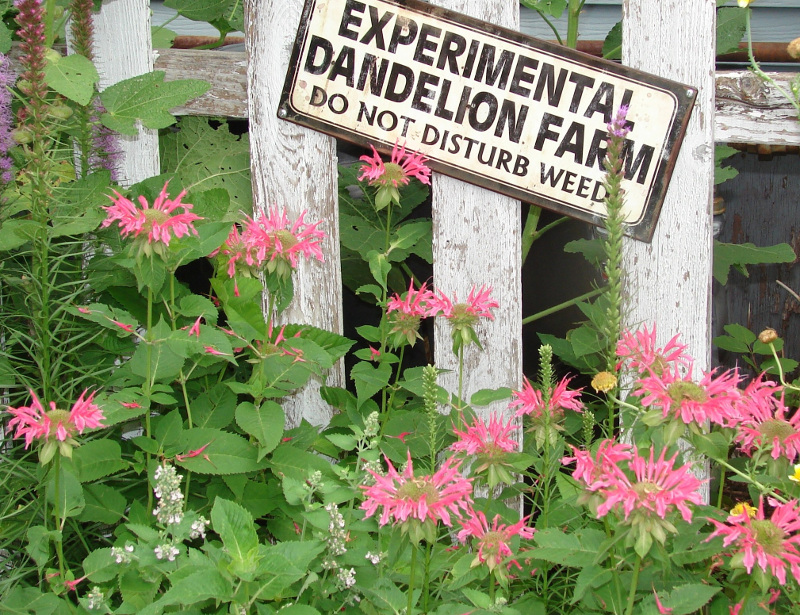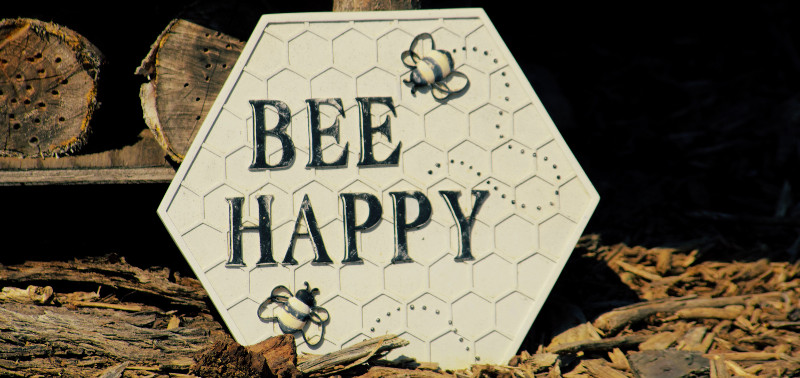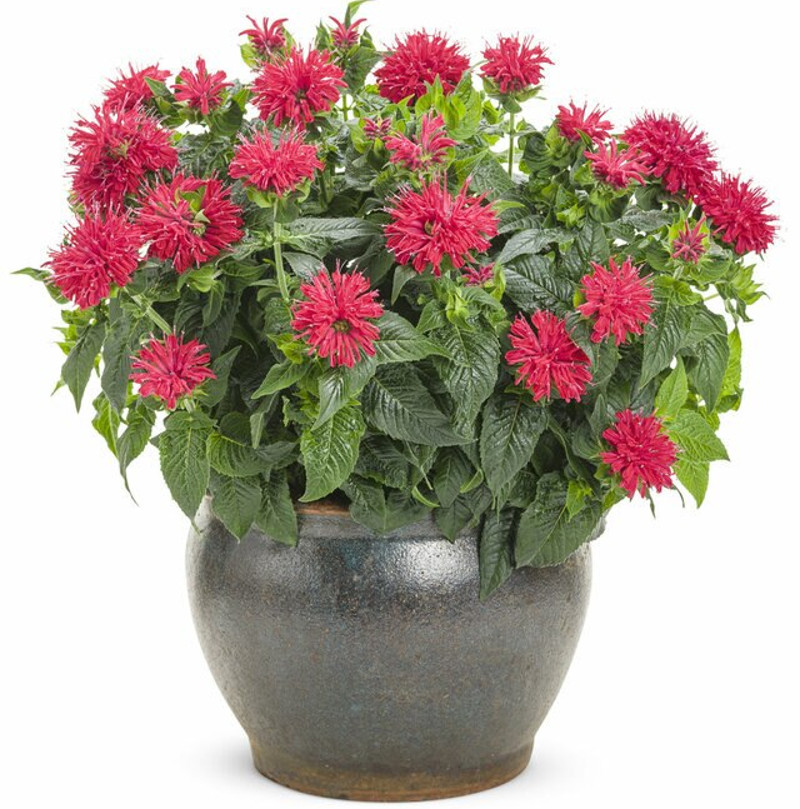Bee Balm (monarda) is a flowering perennial plant that blooms from early summer until fall. Planting, growing and caring for bee balm is extremely easy and its a great plant for gardeners in most of the United States. Bee Balm is native to North America, which makes it great for wildlife including bumble bees & honey bees as the name suggests. Other pollinators also like the plants like hummingbirds & butterflies.
In the fall, the flowers will turn to seed pods called nutlets, which are hard-shelled seeds. Those nutlets are beneficial for several species of birds including redpolls, sparrows, finches, juncos and many other species of birds. Another benefit of growing monarda is that deer, rabbits and other mammals rarely eat the plants unless there isn't any other food sources around.
Read more below about caring for bee balm plants. We've put small snippets about each topic in this article, with separate more in depth articles on each topic if you choose to read more.

Planting Bee Balm
Choose a location that gets at least 6 hours of direct sunlight. In warmer climates, it may be beneficial to provide some shade in the afternoon during the hottest part of the day, but not required. The soil needs to be well-drained. It is best to plant in the spring, but you can also plant during the summer if you provide extra water or during the fall. We recommend adding mulch around the plants to help retain moisture, provide more nutrients in the soil and help protect the roots for harsh weather conditions in the summer and winter. It is especially important to put mulch down if you choose to plant in the fall to help protect the roots during the first winter while the plant gets established.
Watering Bee Balm
Water once or twice per week to help the plant get established. Once the plants are established, water once per week should be enough. The plants are very tough and can handle drought. But a watering schedule can help the plants produce the most amount of flowers possible. The soil needs to be well draining and cannot be wet constantly or the roots will rot and the plants will die. If the leaves are drooping and the soil is completely dry, that is a great indication that water is needed.
Fertilizing Bee Balm
Because monarda is a native plant, feeding bee balm isn't necessary or required. It may be needed if you are growing the plants in pots, because the old soil may need nutrients to be added back. The plants can benefit from fertilizer if you choose to put in the extra effort though. If you choose to fertilize the plants, apply an all purpose 10-10-10 in early spring and that should be enough for the plants for the year.
Deadheading Bee Balm
Pinching off the spent blooms helps encourage the plant to grow new flowers. This is because it tells the plant to put its energy into creating the flower buds instead of turning the old flowers into seedheads. It also helps the appearance of the plant and prevents the plant from spreading seeds to other areas of the garden where you don't want the plant to grow.

Transplanting & Dividing Bee Balm
Bee balm are known for spreading vigorously through the garden if proper steps aren't taken like deadheading before seeds are formed. The good news is that the plants are easily divided and transplanted to new locations if this happens. You can divide bee balm plants every 2 to 3 years to thin the plants out and promote new healthy growth. If you don't have space in your garden or container for more plants, you can always give the plants away to some neighbors, friends or family members!
Bee balm plants will spread through seeds, but also through underground rhizomes. This is why dividing (or splitting) the plants is important to do. Divide monarda in early spring before the plants start to bloom.
Step 1 - dig around the plant, going underneath the deepest roots but not too far underneath the roots.
Step 2 - take the plant out of the hole and shake the loose soil off of the roots.
Step 3 - using a sharp and sterilized knife, cut the plant into 4 new plants as evenly as possible.
Step 4 - follow the planting or transplanting instructions in the new locations. Be sure not to let the roots dry out once you take the plant out of the ground and shake the soil off!
Doing this every 2-3 years ensures the plants are as healthy as possible and ensure the plants produce as many blooms as possible throughout the summer. Plus it's always fun to share plants with other gardeners!
Bee Balm Diseases and Pests
Bee balm is a very tough plant and can handle quite a bit of stress. You may notice bugs on your plants or holes in the leaves. Sometimes there can be yellow or brown spots or small webs on the leaves too. All of these things are indicators that you have a pest problem. We do not recommend using pesticides on the plants because like we mentioned before, many beneficial animals and insects like the plants. If you think you have a pest problem, apply neem oil and that should help get rid of aphids, whiteflies, spider mites, stalk borers and thrips.
Another common problem with the plants is powdery mildew. This is really the only disease that impacts the plants. If you run into this issue, cut off the infected leaves and make sure there is enough space between the plants so there is enough airflow. Those actions will help prevent mildew from spreading. If no action is taken, powdery mildew can be fatal to the plants.
Growing Bee Balm in Pots
A very popular way for gardeners to grow bee balm is in containers. This helps limit the plants from spreading and taking over the garden. The plants make great container plants because they are drought tolerant and can handle harsh conditions. These are very tough plants!
Common Questions About Bee Balm
If you have any questions that we haven't already answered in our articles, feel free to contact us and we would be happy to answer any questions you have about bee balm (or other plants you are trying to grow). Our mission is to help people become successful gardeners!
Are Bee Balm Deer Resistant?
While no plants are truly deer proof, these are seldom considered food for deer and other animals like rabbits.
Are Bee Balm Plants Poisonous?
No, in fact bee balm is in the mint family and the plants are edible.
Are Bee Balm Edible?
Both the leaves and the flowers are considered edible for humans. Bee balm can even be used for tea! You can also use the leaves in salads, lemonade, cooking with meat like poultry and pork, and on pizzas as a substitute for oregano.
Does Bee Balm Spread?
Bee balms do spread, both by seed and underground rhizomes, as well. Deadheading and dividing and thinning the plants are important, as often the center of the plants will die back as they become denser. Division should be done in early spring before they begin to bloom.
Does Bee Balm Come Back Every Year?
Bee balm is an all-season long-blooming perennial, coming back each year.
Should I Deadhead Bee Balm?
Deadheading will help those gorgeous blooms to keep on coming! Your plant will look and feel better, putting more energy into new blooms and this will create more air circulation to help prevent disease, too. As flowers wilt and fade, cut them off just above the next flower bud.
Do Bee Balm Plants Need Full Sun?
Bee balm does better when they get at least 6 hours of direct sunlight, though, in places where it is hotter, some shade in the hottest part of the day isn't a bad thing.
What Are Bee Balm Benefits?
Bee balm is in the mint family and is edible, either fresh or dried. The citrus mint flavor is used in teas and can help with digestive ailments, sore throats, nausea, and bloating. It can also be used topically as an antiseptic to help ward off infection, applied to insect stings and rashes. Its scent is also widely used in aromatherapies.
What Is The Height Of The Bee Balm?
There are dwarf varieties of bee balm that only get to be about 15 inches high, and others that top out at around 4 feet tall.
What Are Common Bee Balm Problems?
Powdery mildew is a common fungal issue for bee balms. This can be avoided by making sure they are properly planted with plenty of space to allow for air circulation, making sure they're receiving at least 6 hours a day of sunshine, and dividing them every few years, for air circulation.
Have a question about Bee Balm? Fill out the form below and we will try and get back to your question as soon as possible. We may even feature your question in this article to help other gardeners!
 |
Author Chris Link - Published 1-15-2021 |
